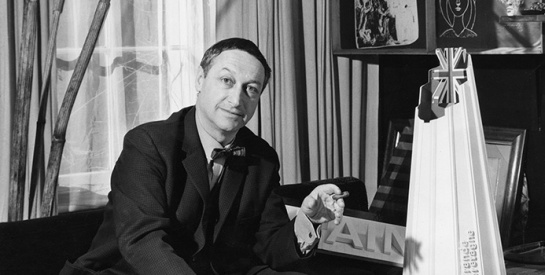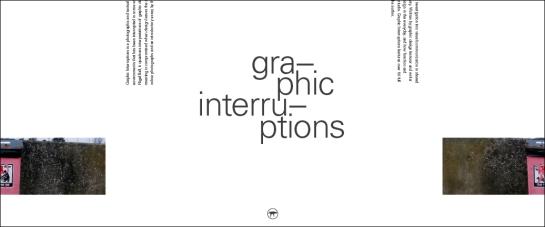With the day job taking over of late, it’s been a while since I’ve managed to get to a graphic design talk. But thanks to an invite from Kemistry Gallery for helping with their recent Kickstarter campaign, I managed to get up to London one evening last week for a talk that was boldly titled Graphic Design: what next? With design critic, journalist, educator and publisher Adrian Shaughnessy; Why Not Associates’ Andy Altmann and designer/artist Daniel Eatock speaking, it would have been rude not to attend. And besides, I was intrigued as to what they would claim was next for graphic design.

Gordon Young/Why Not Associates: Comedy Carpet, 2011. (Photo: comedycarpet.com)
So did any of the speakers answer the question? Well, not exactly. One tried more than the other two, but Andy Altmann, who was up first, did swear at the beginning of his talk that he was instructed to talk about Blackpool’s Comedy Carpet—Why Not Associate’s joint project with artist Gordon Young. And why not, (to coin a phrase)? If anyone should attempt to break the ‘rules’, then I think Andy Altmann has had plenty of experience of doing so and no-one should expect him to change now.
The story of the Comedy Carpet is a truly awe inspiring one, and despite knowing much about the project already, hearing the tale from Altmann himself revealed much more than I could previously ever have known. Interesting memories were keenly told, such as the tale that meeting Ken Dodd at the launch of the project humbling Altmann. However, he still managed to break a cardinal sin of comedy—being bowled over by Dodd telling him a joke while standing on his creation, Altmann blurted out the punchline as he had previously heard the gag. Dodd was not pleased, apparently. (In case you are wondering; Q: “How do you get a fat girl into bed? A: “Piece of cake”.) And the story that Gordon Young, in setting up his own concrete company in order to cut the costs of the project, had to get in one of the UK’s leading experts on concrete who just happened to be Harry Hill’s dad, was gold-dust. (I will resist going into detail here about the Comedy Carpet for those uninitiated with it, check out the dedicated website to the project for more details.)

FHK Henrion (Photo: Unit Editions)
When Adrian Shaughnessy took the stage he wondered how he was going to follow Altmann’s tales, and he was also concerned he had no jokes. But at least he tried to answer the question. In choosing designer FHK Henrion to discuss—of whom Unit Editions had published a book about in 2013—Shaughnessy put the case that as a ‘complete’ designer Henrion demonstrated an attitude that future graphic designers would need to have in this ever evolving discipline. Henrion started his career as a poster artist, in the footsteps of Cassandra and Games. He then went on to be instrumental in introducing visual branding to the UK, producing in-depth identity guidebooks. He also brought his social concerns to the fore by producing work for CND, become an educator, product designer, interior architecture designer and worked in a host of other areas of design, including the emerging field motion graphics for television. A true all-rounder, one of the key aspects of his approach was to bring an open mind to all projects, in terms of what could be achieved, which meant all his work was truly tested the boundaries of design thinking. If the phrase ‘can do’ was invented for anyone, then surely it was for Henrion. In pitching that future designers should avoid becoming a niche entity and be open to all experiences, Shaughnessy put forward a credible case.

Daniel Eatock, 1996. (Photo: Daniel Eatock)
The third and final speaker was Daniel Eatock. I have been a longtime admirer of Eatock’s work and his approach in putting ideas at the heart of his outcomes. For his talk Eatock went for the middle ground and attempted to answer the question at the end after he had spoken about his work. Conceptual as ever, he decided on a system for his presentation: 20 years in 20 minutes, one project a year for one minute each, (an Eatockian Pecha Kucha if you like). He failed, due to over-talking about some projects, but this didn’t matter. It was interesting to hear him discuss his desire in his early practice to try to eradicate subjectivity from his work, fearing that style and decoration was too shallow and over-shadowed the concept. His family’s 1996 Christmas card pictured above was one attempt at this. I would argue that it is impossible to be completely objective in design, for even the choice of typeface and deliberate ‘non-styling’ becomes a style and subjective choice. Regardless, this was a fascinating insight into Eatock’s thinking and was genuinely thought provoking.
In wrapping up his talk Eatock finally attempted to answer the question of ‘what next?’, by providing a slightly awkwardly worded statement. It suggested, (and I paraphrase), that problems shouldn’t necessarily be the starting point of design, and that through investigating outcomes first, we will uncover problems we didn’t previously know existed. Or to put it in simpler terms, produce answers in order to find questions. In throwing out such a knotty statement, Eatock has, for my money, at least tried to answer the question with some sense of critical thinking and avoided defining graphic design purely in terms of commerce which is too often the case. The latter usually closes down critical thinking rather than opening it up, and if graphic design is to be anything other than a means to sell stuff, then we have to resist the market place defining our reference points, even if the market place is where most designers have to operate in order to pay their rent or mortgage.
This very enjoyable evening was rounded off with a Q&A session chaired by Ravensbourne Course Director Liz Friedman, in which education, a hand’s-on approach to design, and ‘post-digital’ became subjects of discussion.
Kemistry Gallery now starts the long haul towards trying to establish a centre for Graphic Design in London.









